Scubaqua, St. Eustatius, Dutch CaribbeanContents of this Issue: Kona Aggressor II, Kona, Hawaii Strobes Don’t Damage the Marine Life Should You Let the “Dentists of the Sea” Clean Your Teeth? Scubaqua, St. Eustatius, Dutch Caribbean Do These So-Called Shark Repellants Keep Sharks at Bay? The Fatal Effects of “Rapture of the Deep” Can a Fish Tell If a Scuba Diver Is Armed? Is Menopause a Cause of the Bends? Is Your Old Computer Still Safe? Your Next Dive Safety Device Might Be . . . an Underwater Tent? Shark Fins Are Banned in 12 U.S. States -- But It’s Still on the Menu Editorial Office: Ben Davison Publisher and Editor Undercurrent 3020 Bridgeway, Suite 102 Sausalito, CA 94965 dive sites rich with history -- and a dive shop with a full bar from the March, 2019 issue of Undercurrent
Dear Fellow Diver: On nearly every dive I did on the Caribbean island of St. Eustatius, I felt like I was finning back into the 18th century. On the way to Three Wrecks, I envisioned the site to be three rust buckets or abandoned barges. But after a backroll off the side of the Yellow Boat and descending 50 feet to a flat, volcanic, sandy bottom, I saw a continuous, 150-foot-long row of ballast stones from wooden sailing ships interspersed with long-shank anchors, cannons, barrel hoops and metal artifacts, all encrusted with coral. They had come from three wooden sailing ships that had sunk together there about 250 years ago. Just poking around would have been enough for me, but I saw green and speckled morays, and numerous blennies under the coral overhangs. Some divers saw octopuses; I got frame-worthy photos of a bright yellow, immature, long-snout seahorse. Looking up, I saw five Caribbean reef squid hovering above, watching me. They hung around for five minutes, but I got tired and ended our encounter. I gradually ascended in calm, 81-degree water with a big smile on my face.
One of those warehouses, possibly owned by the Dutch West India Company, is Scubaqua's dive shop. My 30-person group chose to dive in January with this eco-friendly and very laid-back (I'll tell you about the bar later) operation run by two European couples and staffed with a global mix of divemasters who each spoke at least two languages. Mike and Marieke, the Dutch owners, separated us into two groups, then subdivided us into groups of four or five per divemaster, who were always in the water with us. We partially suited up in our shorties and 2-mm wetsuits at the shop, then piled into the back of a pickup truck and drove a halfmile to the commercial pier. My group of experienced divers got in the smaller Yellow Boat, a 27-foot mono-hull boat with only a small Bimini top for shade. The rest of the divers boarded the Green Flash¸ a 36-foot fiberglass Sea Hawk that could fit up to 25. One morning, Rolf, an always-smiling Dutchman who had guided in the Philippines and Asia, drove us to Blue Bead Hole, a non-picturesque site but one unlike any I've seen. It's a small patch far out in the harbor that can only be found by GPS (topsecret coordinates, per Scubaqua staff). I descended to 60 feet, kneeling on sand and eel grass without any coral or other visual charms. The objective was to find rare, historical blue beads, five-sided and a half-inch long. In the 18th century, the Africans living as slaves on Statia weren't allowed to have money, so the Dutch created a monetary system they could use, giving them these indigo beads for good behavior that could be redeemed for some luxuries. No one knows why there's such a concentration of these beads at this particular site, just a dozen yards across and 50 yards long. Speculation was that at the time of emancipation on Statia, in 1833, the former slaves went to the cliffs and along the shore and threw all their beads into the sea. Of my group of nine divers, three found beads. Scubaqua requested and received all our paperwork (passports, signed waivers, certifications and diving history) before we arrived, so on-site check-in was a breeze. Nitrox was free with my package, and mixtures from the high-end system were always correct to the tenth of a percent, thanks to Antone, the gas blender. I also paid for the concierge diving package, which meant crew took my gear to the boat the first day and set it up, then I confirmed everything was the way I wanted it. After that, all I did was dive. I left my weights below my seat, and they took my gear to the shop to wash, hang and dry in a secure area.
I didn't worry about stumbling back to my hotel afterwards, because the Old Gin House was just 100 feet away. It's named for the cotton "gin," the processing machine housed there when cotton was king, although it became a public guesthouse in 1760. Sybolt and Marlies ten Hoopen, the Dutch couple who run the place, were always accessible in their office, on the ground floor of a square, faded brick, two-story building lined with pillared patios and topped by a corrugated metal roof. I crossed the sreet to reach my oceanview room in the newest building, a yellow stucco, three-story structure draped with bougainvillea(I had read Undercurrent reader reports that rooms in the main building are small and need TLC). Mine had two double beds, free WiFi, a small balcony, unlimited bottled water (don't drink the tap water) and unlimited solar-heated water in the tiled shower. Daytime temperatures only reached the high 70s, so I didn't need the AC. I easily fell asleep to the sound of gentle waves but unfortunately, the tomcats started fighting and the roosters started crowing before dawn. Cable TV was nil -- although advertised, I was later told it had not worked since Hurricane Irma two years ago. I mostly spent my downtime across the street at Old Gin's waterfront bar and restaurant, my group's meeting area for sunset viewing and socializing. One evening, I got lucky and took a photo at the exact moment of the "green flash" at sunset.
Christele (French) and Alex (German) briefed us before we left the dive shop, using visual images, like prepared charts and photo albums of critters, which gave me a good concept of what I'd see on each dive. But Scubaqua's photography support was borderline -- for rig-wielding photographers like me, the lack of camera table and rinse bucket on the Yellow Boat was frustrating. Camera storage was limited to the best spot I could find, and asking other divers to please not step on my camera. Most dive sites were only five to 10 minutes away, so I was glad the boats returned to the shop for an hour between every dive, and I could place my camera in one of two dedicated rinse tanks. All of Statia has been a marine park, named STENAPA, for 20 years, so the taking of marine life is limited. I only saw older gentlemen fishing; seems they were "grandfathered" in with continued fishing privileges. STENAPA is regularly rated as a top Caribbean dive site due to regenerating or enlarging coral formations, and higher-than-average numbers of sea turtles. Hangover, a spur-and-groove reef at 60 feet formed by lava flows from the Quill volcano (which last erupted around 1,500 years ago), was a favorite of turtles that liked sleeping under its ledges. I watched a hawksbill swim under an overhang, then somehow increase its buoyancy, float up against the overhang, and close its eyes. A larger green turtle apparently wanted me to scratch his back. It swam up to me while Christele watched, and I backed away, knowing it's poor diver etiquette to touch marine life. But he kept coming, so I finally had to turn him around and start him in another direction. Easy to spot in the 100-foot visibility, where the reef system dropped into the abyss, was a Caribbean reef shark that did a 180-degree turn and returned for another fly-by.
Dives ranged between 50 and 90 feet, but the dive site STENAPA was the deepest. I went hand-over-hand down the line to the mooring at 50 feet, hooked up with my buddy, then proceeded over the edge of a drop-off to well below 90 feet. We circumnavigated small promontories, with black coral, whip coral and soft coral fans draped along the wall. I've never seen more large and healthy Carribbean lobsters; there were frequently dozens on a dive. I saw three Caribbean reef sharks off to the right . . . or maybe it was the same one circling three times? Others in my group were sure there were more than that -- we debated it over post-dive beers back at the shop. Washed up and changed for dinner, I was served by Marieke, who doubled as the head waiter. A typical menu one evening was conch fritters or lobster bisque as appetizer; entrée choices of lobster pasta alfredo or beef or chicken fajitas, with Italian chocolate cake for desert. Sometimes we walked down the road to the Harbor Club for dinners of BBQ ribs, Angus steak or fish pasta, with side choices of fries, rice or green salad. The Boardwalk, next door on the pier, seemed the closest Statia had for a nightlife hotspot. One night, I met a team of underwater archeologists investigating a wreck in the harbor. A dive shop rumor held that it was a Dutch slave ship from the 1600s, but the archeologists were tight-lipped, even when I offered to buy them dinner if they gave us the scoop (maybe they had nothing to say yet).
One of my final dives was to Two Wrecks, similar to Three Wrecks at the top of my story, but deeper, at 70 feet. It was home to several playful octopus - one was a free-swimmer and another loved to play peek-a-boo. I watched the action in a turtle cleaning station, with yellow wrasse and blue tang ending to a customer. Then I laughed in my regulator at a pikeblenny frantically fighting its own image in the mirror Alex placed near its home. A curious hawksbill turtle swam around us as we ascended up the mooring ladder, waving its flippers as if to say farewell. Statia, with its sleepy vibe and gracious hospitality, feels like a remnant of the old Caribbean from decades, even centuries, ago. Its reefs lacks larger fish and pelagics, but the other marine life and coral are superb. And it truly is a unique standout for offering a glimpse of some fascinating New World history that you'll not see anywhere else. -- D.D. Our Undercover Diver's Bio: "I got my dive certification at the YMCA back in the 1970s, but I didn't do much diving until I moved to Los Angeles in 1990. Then I got recertified and rapidly received certificates for technical diving and rebreathers. I've been doing about 100 openwater dives a year for the last 25 years with a good local dive group, and I've dived all around the world but certainly not everywhere. I presently have more than 1,500 openwater dives under my belt and about 200 technical/ rebreather dives, although I don't do those anymore. I just like to dive."
|

I want to get all the stories! Tell me how I can become an Undercurrent Online Member and get online access to all the articles of Undercurrent as well as thousands of first hand reports on dive operations world-wide
| Home | Online Members Area | My Account |
Login
|
Join
|
| Travel Index |
Dive Resort & Liveaboard Reviews
|
Featured Reports
|
Recent
Issues
|
Back Issues
|
|
Dive Gear
Index
|
Health/Safety Index
|
Environment & Misc.
Index
|
Seasonal Planner
|
Blogs
|
Free Articles
|
Book Picks
|
News
|
|
Special Offers
|
RSS
|
FAQ
|
About Us
|
Contact Us
|
Links
|
3020 Bridgeway, Ste 102, Sausalito, Ca 94965
All rights reserved.

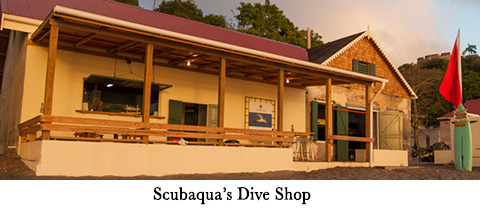 St. Eustatius, "Statia" for short, is a Dutch Special Royal District, like Bonaire.
The little island has fewer than 4,000 people, but it's rich with history. I heard, several
times, that Statia had the world's busiest harbor in the early to mid 1700's. Now,
just a few oil tankers used the harbor in the (only) town of Oranjestad, headed to the
oil distribution facility on Statia's northern end, which is, thankfully, out of sight.
While sitting around the oceanside bar at the Old Gin House at night, learning from the
locals about Statia's past, I imagined
a waterfront resembling something from
a Pirates of the Caribbean movie. Many
worn-out sailing vessels just sank;
they're now piles of ballast stones
and a few cannon in 50 feet of water,
providing homes to schools of Creole
wrasse, pygmy seahorses and hawksbill
turtles. Statia's old harbor road runs
two miles along its west coast. Of the
100 or so buildings along it that were
warehouses and homes 300 years ago, only
a dozen have been restored as restaurants,
a museum, B&Bs and small hotels,
like the Old Gin House, where I stayed.
St. Eustatius, "Statia" for short, is a Dutch Special Royal District, like Bonaire.
The little island has fewer than 4,000 people, but it's rich with history. I heard, several
times, that Statia had the world's busiest harbor in the early to mid 1700's. Now,
just a few oil tankers used the harbor in the (only) town of Oranjestad, headed to the
oil distribution facility on Statia's northern end, which is, thankfully, out of sight.
While sitting around the oceanside bar at the Old Gin House at night, learning from the
locals about Statia's past, I imagined
a waterfront resembling something from
a Pirates of the Caribbean movie. Many
worn-out sailing vessels just sank;
they're now piles of ballast stones
and a few cannon in 50 feet of water,
providing homes to schools of Creole
wrasse, pygmy seahorses and hawksbill
turtles. Statia's old harbor road runs
two miles along its west coast. Of the
100 or so buildings along it that were
warehouses and homes 300 years ago, only
a dozen have been restored as restaurants,
a museum, B&Bs and small hotels,
like the Old Gin House, where I stayed.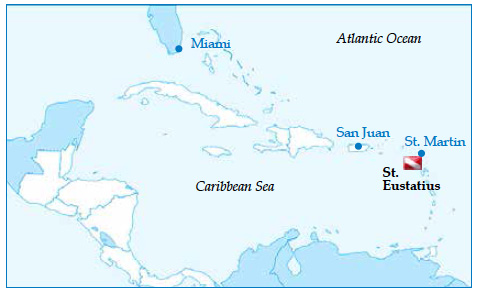 I noted two unique aspects to diving
with Scubaqua that I've not seen in 30 years
of diving. The first is that all divers, and
even crew, always had to go through Dutch
Customs to get on the boats, then had to
check in again after returning. My group
laughed that we had "emigrated" to and from
Statia at least 16 times that week. It was
easy -- I just walked past and gave my name
when exiting and returning. The second feature
was that Scubaqua had a fully equipped bar in
the dive shop, which opened around 4:30 every
afternoon. We sat around with beers and mixed
drinks, and talked about the day's diving with
the divemasters while they filled cylinders,
and washed and stored equipment. I chalked that up to the Dutch's relaxed attitude of
enjoying life.
I noted two unique aspects to diving
with Scubaqua that I've not seen in 30 years
of diving. The first is that all divers, and
even crew, always had to go through Dutch
Customs to get on the boats, then had to
check in again after returning. My group
laughed that we had "emigrated" to and from
Statia at least 16 times that week. It was
easy -- I just walked past and gave my name
when exiting and returning. The second feature
was that Scubaqua had a fully equipped bar in
the dive shop, which opened around 4:30 every
afternoon. We sat around with beers and mixed
drinks, and talked about the day's diving with
the divemasters while they filled cylinders,
and washed and stored equipment. I chalked that up to the Dutch's relaxed attitude of
enjoying life.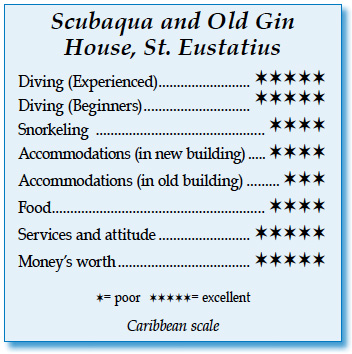 I met my group again at daybreak, when coffee was available in the restaurant.
Breakfast started at 7 a.m. and consisted of cold cuts, cheeses, croissants or rolls,
a fruit cocktail and a cup of fruit-flavored yogurt. Either Achema or Jacinthia took
my order for a hot breakfast -- eggs, omelets, bacon, hot cakes or smoked salmon with
capers. Before heading to the dive shop, I gave my requests for the sandwich lunch
delivered to Scubaqua for eating after the second dive. (Special meals were provided
for those who notified the chef beforehand.)
I met my group again at daybreak, when coffee was available in the restaurant.
Breakfast started at 7 a.m. and consisted of cold cuts, cheeses, croissants or rolls,
a fruit cocktail and a cup of fruit-flavored yogurt. Either Achema or Jacinthia took
my order for a hot breakfast -- eggs, omelets, bacon, hot cakes or smoked salmon with
capers. Before heading to the dive shop, I gave my requests for the sandwich lunch
delivered to Scubaqua for eating after the second dive. (Special meals were provided
for those who notified the chef beforehand.)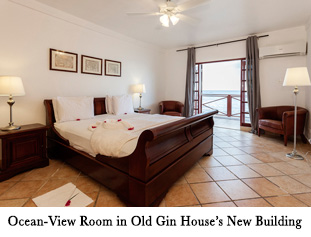 Although we were told during the initial briefing that dives were limited to 40
minutes, it wasn't long until most of us stayed underwater for over an hour. They
stayed strict about surfacing with a buddy and kept track of divers' remaining air
time -- when it was time for the first diver to start up, Alex paired him or her with
someone who had the same remaining air time to surface together. After a couple days,
Alex had figured his air consumption was about the same as for me and my buddy, so we
were often last to surface and climb the sturdy ladder. Rolf helped me aboard, and I
sat on the gunwales while he stacked the aluminum 80s and gear along the sides.
Although we were told during the initial briefing that dives were limited to 40
minutes, it wasn't long until most of us stayed underwater for over an hour. They
stayed strict about surfacing with a buddy and kept track of divers' remaining air
time -- when it was time for the first diver to start up, Alex paired him or her with
someone who had the same remaining air time to surface together. After a couple days,
Alex had figured his air consumption was about the same as for me and my buddy, so we
were often last to surface and climb the sturdy ladder. Rolf helped me aboard, and I
sat on the gunwales while he stacked the aluminum 80s and gear along the sides.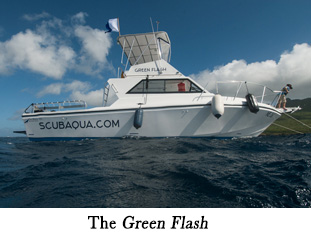 One afternoon, I got on a 20-passenger
Toyota van for the island tour, headed first
to the turtle nesting beach, then to the
remains of what may be the oldest Jewish
synagogue in the Western Hemisphere. At the
southern tip, I ogled the volcanic Quill,
then walked a hilltop fort to admire clear
views of St. Kitts, 10 miles to the south.
Back in Oranjestad, sea views from the thoroughly-restored main fort, built in 1660,
were equally lovely. I enjoyed walking the cobblestone streets, built of old ships'
ballast stones, and savoring the quiet -- charming Oranjestad is free of souvenir
shops, and has almost no tourist activities.
One afternoon, I got on a 20-passenger
Toyota van for the island tour, headed first
to the turtle nesting beach, then to the
remains of what may be the oldest Jewish
synagogue in the Western Hemisphere. At the
southern tip, I ogled the volcanic Quill,
then walked a hilltop fort to admire clear
views of St. Kitts, 10 miles to the south.
Back in Oranjestad, sea views from the thoroughly-restored main fort, built in 1660,
were equally lovely. I enjoyed walking the cobblestone streets, built of old ships'
ballast stones, and savoring the quiet -- charming Oranjestad is free of souvenir
shops, and has almost no tourist activities. Divers Compass: Old Gin House charges $265 per night for an ocean-view
room and $245 per night for a garden-view room . . . I paid $800 for
18 dives with Scubaqua; night dives are $60, with a six-person minimum
. . . Scubaqua offers new AquaLung gear for rentals . . . I flew Delta
from the Midwest to St. Martin, followed by a 30-minute turboprop
flight to St. Eustatius, and paid $900 round-trip; our 33-person dive
group used both St. Martin Air and Winair for the Statia flights so we
could get there all at once on their small fleet . . . Scubaqua met us
at the airport with a van and flatbed truck for the gear bags, which
showed up in front of my room shortly after; on departing, I put my bags in front of
my room, and they showed up at Statia airport for check-in . . . I left Statia on a
6 a.m. flight, but I should have taken the noon flight, because I then had to wait in
St. Martin for eight hours before the big airlines opened their check-in desks, shortly
before their late-afternoon departures . . . Drink prices were quite reasonable; a
large glass of California, European or Argentina wine was $8, Caribbean beers were $3 to $5 . . . The ATM in town gave Euros, but most prices were listed in U.S. dollars,
which were readily accepted . . . Statia has a hyperbaric chamber . . . Websites:
Scubaqua -
Divers Compass: Old Gin House charges $265 per night for an ocean-view
room and $245 per night for a garden-view room . . . I paid $800 for
18 dives with Scubaqua; night dives are $60, with a six-person minimum
. . . Scubaqua offers new AquaLung gear for rentals . . . I flew Delta
from the Midwest to St. Martin, followed by a 30-minute turboprop
flight to St. Eustatius, and paid $900 round-trip; our 33-person dive
group used both St. Martin Air and Winair for the Statia flights so we
could get there all at once on their small fleet . . . Scubaqua met us
at the airport with a van and flatbed truck for the gear bags, which
showed up in front of my room shortly after; on departing, I put my bags in front of
my room, and they showed up at Statia airport for check-in . . . I left Statia on a
6 a.m. flight, but I should have taken the noon flight, because I then had to wait in
St. Martin for eight hours before the big airlines opened their check-in desks, shortly
before their late-afternoon departures . . . Drink prices were quite reasonable; a
large glass of California, European or Argentina wine was $8, Caribbean beers were $3 to $5 . . . The ATM in town gave Euros, but most prices were listed in U.S. dollars,
which were readily accepted . . . Statia has a hyperbaric chamber . . . Websites:
Scubaqua - 